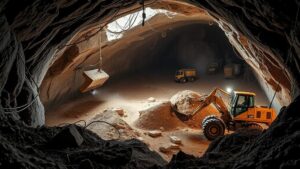Mining With Primitive Tools: A Look at Early Human Ingenuity
Mining With Primitive Tools: A Look at Early Human Ingenuity
The history of human civilization is intertwined with our ability to extract and utilize natural resources. From the earliest days of humanity, mining has played a crucial role in societal development. This article explores early mining techniques that employed primitive tools, showcasing human ingenuity and the significant impact these practices had on ancient societies.
Understanding Primitive Mining Techniques
Primitive mining techniques developed as early humans sought materials to enhance their survival and quality of life. tools used during this period were primarily crafted from readily available resources, such as stone, wood, and bone. The methods employed can be categorized into two main forms: surface mining and underground mining.
- Surface mining: This method involved extracting minerals and ores located close to the earths surface. Early humans would use hand tools like digging sticks and sticks to remove soil and rock layers.
- Underground mining: More advanced than surface mining, this technique required the development of shafts and tunnels. Tools made from sharpened wood or primitive metal aids were instrumental in this process.
Notable Tools Used in Primitive Mining
The effectiveness of early mining was greatly influenced by the tools available to miners. Some common tools include:
- Stone Hammers: Used for breaking rock, these tools were made from hard materials like flint or granite. Their design allowed early miners to effectively extract ore.
- Digging Sticks: Simple yet effective, these tools were used to remove loose materials and soil, revealing valuable resources below.
- Fire: Ancient miners discovered that applying heat to certain rocks could make them easier to fracture. This technique, known as fire-setting, was pivotal in underground mining.
Case Study: The Tsumeb Mine in Namibia
The Tsumeb Mine, established around the 700s AD, serves as an excellent example of early mining practices. The indigenous people extracted copper, lead, and zinc using basic tools and techniques. The mines productivity was significant enough to establish trade routes, demonstrating the early understanding of resource extractions economic potential.
Social and Economic Impacts of Primitive Mining
The effects of primitive mining extended beyond mere survival. As societies began to harness minerals, several important changes occurred:
- Trade Development: The extraction and commercialization of valuable ores led to the formation of trade networks. It allowed ancient communities to trade minerals for goods, fostering economic development.
- Technological Advancement: As mining became more widespread, tools and techniques evolved. This included the transition from simple stone tools to smelting processes, which utilized copper and bronze.
- Cultural Significance: Mineral extraction led to the creation of artifacts, jewelry, and art, reflecting the social structures and beliefs of ancient communities.
Conclusion
Primitive mining serves as a testament to early human ingenuity and resourcefulness. tools and techniques developed laid the foundation for the extensive mining operations we see today. Understanding these historical practices not only highlights our ancestors’ adaptability but also reminds us of the intrinsic relationship between society and natural resources. As modern miners apply advanced technologies, the legacy of early mining techniques continues to inform and inspire contemporary practices.
Actionable Takeaways
- Explore the local geology in your area to understand the potential for extraction, reflecting early practices.
- Learn about the evolution of mining tools to appreciate the advancements in technology.
- Consider the social implications of mining in historical contexts to better understand its economic impact today.


